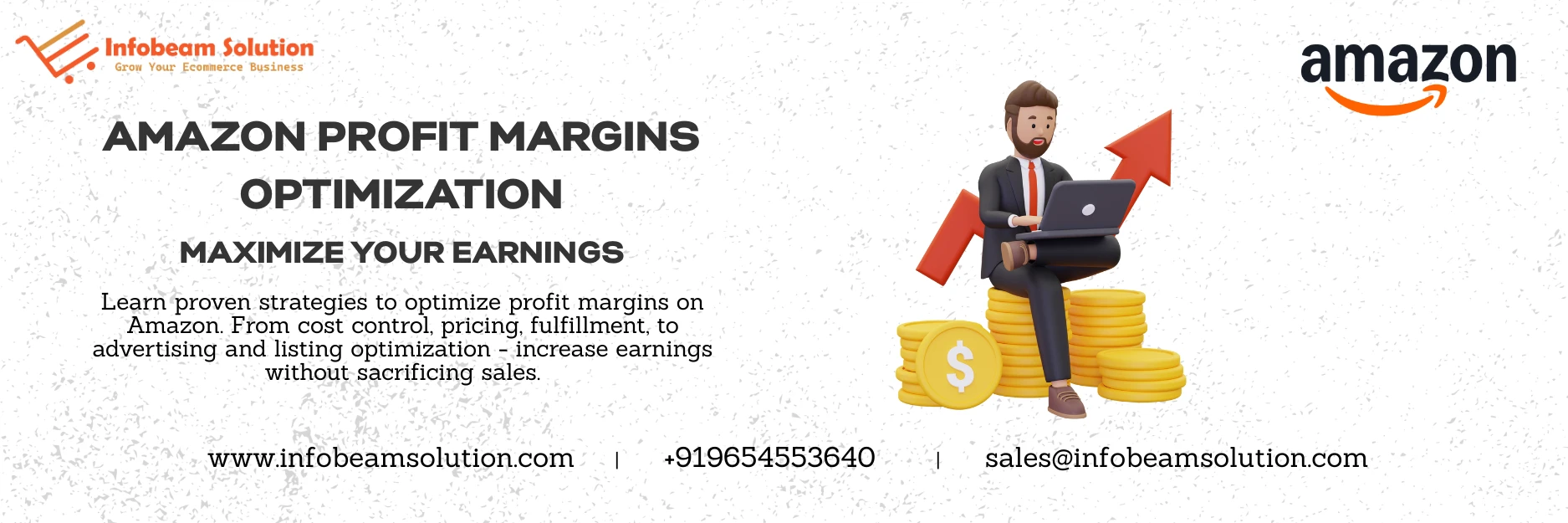Amazon Profit Margins Optimization: Maximize Your Earnings
Getting sales on Amazon is just part of the game. The real win is keeping more of what you earn. Optimizing profit margins ensures that as sales grow, your earnings scale too. Below are strategies you can put in place now to improve margins, reduce waste, and boost your bottom line.

Table of contents
- Amazon Profit Margins Optimization: Maximize Your Earnings
- 1. Accurately Calculate All Costs
- 2. Optimize Pricing Without Under-selling
- 3. Reduce Fulfillment & Storage Overheads
- 4. Improve Conversion / Listing Effectiveness
- 5. Optimize Advertising Spend for ROI
- 6. Negotiate Supplier and Cost Inputs
- 7. Regular Review & Data-Driven Adjustments
- 8. Use Tools & Automation to Scale Margin Gains
- Final Thoughts
- Related Posts
1. Accurately Calculate All Costs
- Cost of Goods Sold (COGS): Include purchase, manufacturing, import duties, and any supplier-side costs.
- Fulfillment & Shipping Fees: Whether using FBA or other courier services, account for picking, packing, shipping, and last-mile fees.
- Amazon-Related Fees: Referral, storage, long-term storage, returns, advertising, and subscription fees.
- Hidden Costs: Damages, unstockable returns, inventory losses, extra packaging or weight surcharges.
Knowing your break-even point per unit is essential, this becomes your baseline for pricing, discounting, and promotions.
2. Optimize Pricing Without Under-selling
- Use dynamic pricing tools to adjust prices based on competition, demand, and stock levels, while protecting your margin floor.
- Offer bundle deals or multi-pack options: this helps increase average order value and reduce per-unit costs (packaging, shipping).
- Use coupons or deals strategically, not constantly, but to move slow SKUs, clear excess stock, or during high-traffic seasons.
3. Reduce Fulfillment & Storage Overheads
- Evaluate whether FBA or self-fulfillment makes sense for each product line: FBA offers ease and visibility but may have higher storage and service fees.
- Optimize packaging size and weight: smaller, lighter, well-protected packaging can reduce shipping and storage costs.
- Remove slow-moving inventory or clearance it early to avoid long-term storage fees.
4. Improve Conversion / Listing Effectiveness
- Strong listings convert better, which means fewer wasted ad spends or markdowns. High-quality images, persuasive bullet points & titles, and optimized backend keywords help.
- Use A+ or Enhanced Brand Content if eligible, to differentiate product value and command a slightly higher price.
- Address common buyer objections proactively (size, durability, compatibility) to reduce returns or refunds.
5. Optimize Advertising Spend for ROI
- Monitor your advertising metrics closely: ACOS (Advertising Cost of Sales), ROAS, click-through rate, conversion rate. Pause or adjust ads that don’t deliver profitable returns.
- Focus ad budgets on high-margin SKUs rather than spreading thin across many low margin ones.
- Use negative targeting or keyword exclusions to reduce wasted spend.
6. Negotiate Supplier and Cost Inputs
- If possible, negotiate lower costs with suppliers, bulk discounts, or better terms (MOQ, payment terms).
- Explore alternative suppliers or materials that maintain quality but reduce cost.
- Manage freight & transportation costs, shipping methods, shipping partner selection, bulk shipments to reduce costs.
7. Regular Review & Data-Driven Adjustments
- Use Amazon reports and external tools to track metrics such as margin per unit, return rates, storage fees, inventory turnover.
- Set periodic audits to identify SKUs whose margins have eroded due to rising costs, competitor pressure, or Amazon fee changes.
- Apply small adjustments, testing price changes, packaging tweaks, supplier changes, and measure impact before scaling.
8. Use Tools & Automation to Scale Margin Gains
- Use repricing software that incorporates your cost floor and margin targets so you don’t have to monitor price manually.
- Automate inventory alerts so you don’t suffer loss from dead inventory or stockouts.
- Tools for cost tracking, profitability per SKU dashboards can help quickly identify bleed points.
Final Thoughts
Optimizing profit margins isn’t sexy, it’s hard work, but it’s where sustainable success on Amazon lives. By understanding your costs, making smart pricing and fulfillment decisions, optimizing your ad spend, and always watching the data, you ensure that more of your revenue ends up as real earnings.
Start identifying the biggest cost drains in your store today, test out adjustments, and double down on what works. With consistent effort, your profit margins can grow alongside your sales.